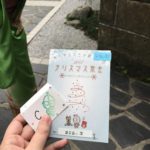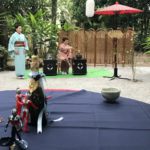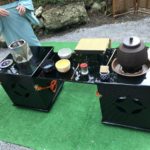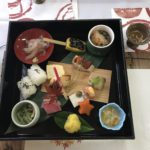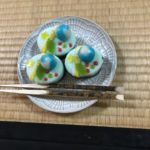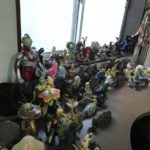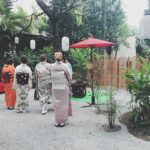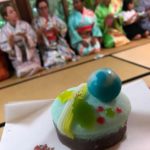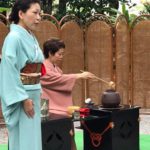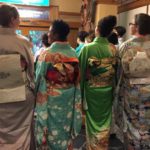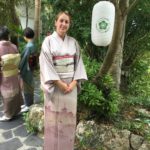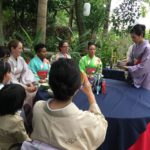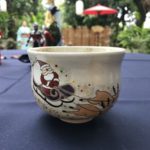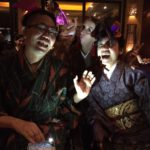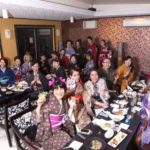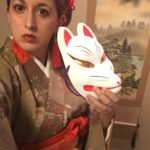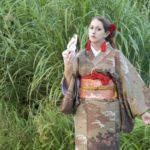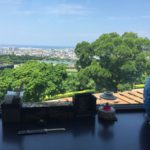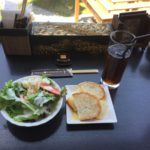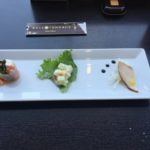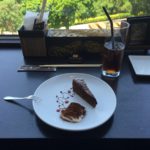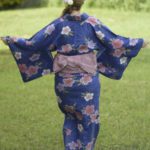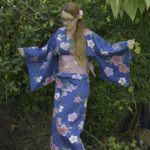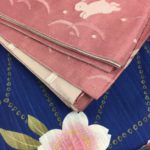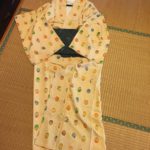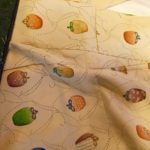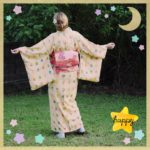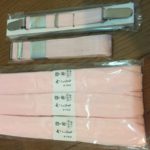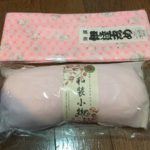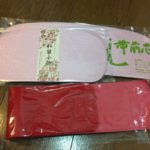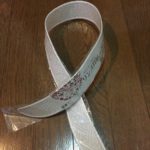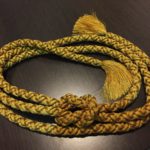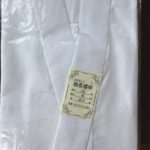茶会 chakai: a tea “gathering,” a more informal tea ceremony.
クリスマス kurisumasu: Christmas
Recently I had the good fortune to attend a chaikai 茶会 here in Okinawa. The location was at Shoufuuen 松風苑 in Haebaru 南風原 (southern part of the island), the birthplace of Ultraman ウルトラマン (hometown of Tetsuo Kinjo, scriptwriter)! The theme of the chakai was Christmas, and of course, with a little Ultraman thrown in the mix.
Anyway, I dressed myself in kimono and met up with some fellow foreigners at the event venue. Of course, as a foreigner who dressed themselves in kimono and speaks some Japanese, many people found their way to talking to me. I don’t think it is so impressive for me to do these things, but Japanese people are often overly kind and complimentary regarding these things. It was a little embarrassing for me as I did not actually have time to do my hair and make-up properly due to oversleeping, so I had rushed to get ready.
The venue consists of some beautiful buildings and gardens set away from the main road; it is one of the few places here in Okinawa where I felt more of the Japanese atmosphere (rather than Ryukyu or Chanpuru cultures).
In general, a chakai is a little less formal than a proper tea gathering ceremony, called a chaji 茶事. This particular event was a 3-part event (lasting a little less than 3 hours total): tea ceremony outside, light meal, and an indoor tea ceremony. For the first tea we were seated at a table outside and served tea with 2 types of wagashi. Afterwards met with a famous potter here in Okinawa; he made the giant shisa that sit on either side of Kokusai-dori area in Naha. He also made the small pottery cups that were used (and we got to take home) during our light meal.
The light meal was held inside the banquet area. It was tatami seating, so properly one should sit seiza 正座, but as a foreigner that is a bit difficult for long periods of time so… I did not, despite the awkwardness of sitting in kimono. The little pottery cup we received as a souvenir has a design for the New Year… the year of the dog! This made me very happy as coming new year, the year of the dog 戌年 (inudoshi) is my zodiac year. The meal was beautifully and carefully prepared, as well as quite filling. I cannot remember everything in it, but the only meat was the chicken (which I did not eat); there was of course fish/seafood, which I ate on this occasion (though admittedly I am not a huge fan of fish in general).
Anyway, next was the last tea ceremony held in one of the more formal tea ceremony rooms. It was beautifully decorated. Again, this time we sat seiza for the whole time and admittedly I need practice as my feet became a bit painful. But overall I enjoyed the entire thing.
After the last ceremony, we found ourselves going up to the small “museum” dedicated to Ultraman. It is only 2 small rooms, but very cute and interesting. When not used as an event space, Shoufuuen is also a restaurant… I definitely recommend trying it sometime for a nice kaiseki (traditional multi-course Japanese/Okinawan meal) experience!
Posted below are a few pictures from the event; I could add so many more, but tried to choose some of the better and more relevant ones. Hopefully everyone who spends time in Okinawa or Japan will take the opportunity to attend a chakai!
address: https://goo.gl/maps/8wKb1rhbLBx
